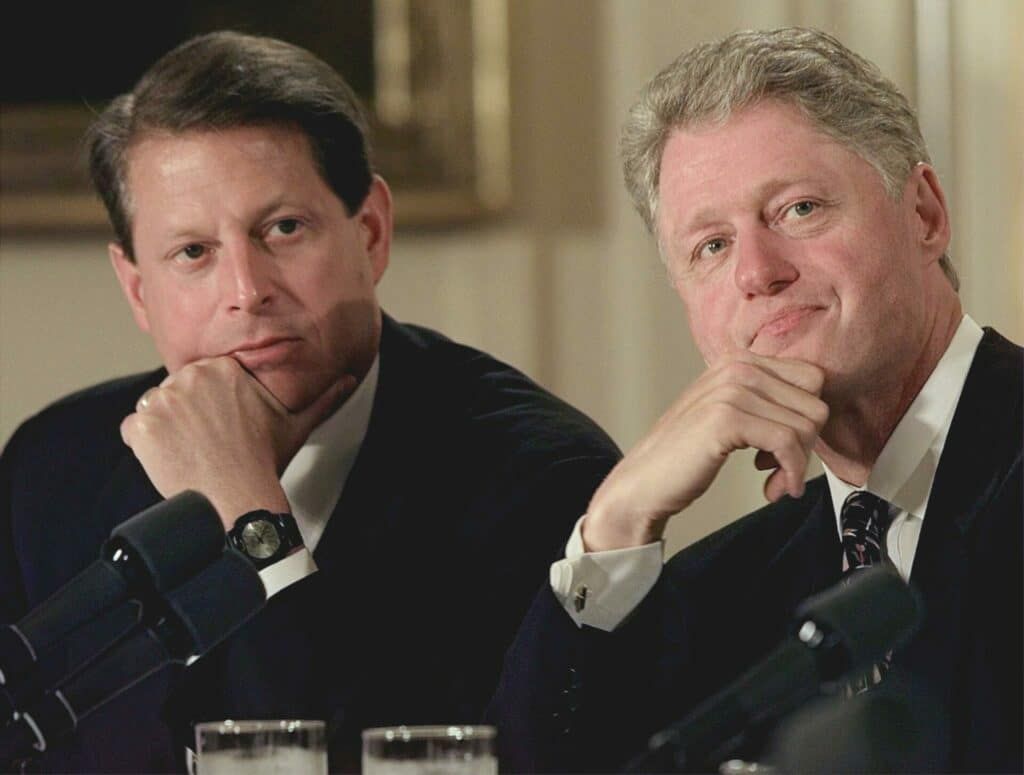How weathercasters helped change public opinion on climate change
By John Morales | October 24, 2022
 President Bill Clinton (R) and Vice President Al Gore (L) at an East Room round table event discussing climate change at the White House in July, 1997. STEPHEN JAFFE / AFP via Getty Images.
President Bill Clinton (R) and Vice President Al Gore (L) at an East Room round table event discussing climate change at the White House in July, 1997. STEPHEN JAFFE / AFP via Getty Images.
Twenty-five years ago this month, the Clinton administration hosted 100 broadcast meteorologists at the White House for a series of briefings on global climate change.
Addressing a roomful of weathercasters, President Clinton panned, “Welcome to the White House on a cool, overcast day—about 60 degrees. How am I doing? I’m auditioning.” Those in the East Room crowd, including me, laughed pretty hardily at the president’s opening lines. But this wasn’t a social function. It was a climate change convocation.
Clinton was about to throw a Hail Mary, with weathercasters the intended receivers.
“This climate change issue is one of the principal challenges that we face… [It’s] a profoundly important issue and one, frankly, that you, just in the way you comment on the events that you cover, may have a real effect on the American people,” the president went on. “You have more influence than anybody does on how the American people think about this.”
“I think that they were looking around saying, ‘We have important information here, but we’re not making a dent in the public discussion’,” meteorologist Bryan Norcross explained to me recently; at the time, Norcross presented the weather at WFOR in Miami and is now a hurricane specialist at Fox Weather.
It was a crucial time in the fledgling public debate on climate. Now in its second term, the Clinton administration was struggling to make headway on the environmental and climate fronts.
Negotiations for the Kyoto meeting of the United National Framework Convention on Climate Change (UNFCCC) were in the home stretch. But American industry and labor groups were spending millions of dollars in lobbying and advertising to oppose any strict targets on greenhouse gas emissions that might come from the Kyoto Protocol.
Just a few years earlier, Clinton’s first term had started with high aspirations for progressive environmental and climate policies. Vice President Al Gore was tasked with spearheading the effort. But the environmental agenda quickly got bogged down, including the emblematic failure of the so-called BTU-tax, a tax on energy designed to combat global warming.
The 1994 midterm election Republican takeover of Congress led by Newt Gingrich followed, which is often cited as the catalyst for the modern cycle of political polarization in this country.
The 104th Congress was ultimately unsuccessful in attempts to rewrite or undo many of the environmental regulations enacted since the 1970s, but the Clinton-Gore White House had to back-off from its aggressive pro-environment agenda. Al Gore was becoming the face of climate change in an increasingly politically polarized country. It didn’t matter that what Gore presented was based solid scientific evidence—those on the other end of the political spectrum, including so-called conservative media, didn’t want to hear it.
Even so, the Clinton administration’s outreach to meteorologists had impact over time, persuading some television weathercasters—including me—to begin including climate as part of their day-to-day presentations and others to follow suit over time, often customizing the message to reach conservative audiences wary of the warnings of climate scientists. As a result, the American public has an improved understanding of the climate crisis that the TV weathercasters of the 21st century need to keep building on.
Weathercasting and climate change communication. By late in the 20th century, broader efforts to keep Americans confused on the subject of global warming were already in full display. A deliberate disinformation campaign by special economic interest groups, their lobbyists, and the politicians that benefited from their political contributions had effectively fooled American news media into serving as an unknowing accomplice in disseminating climate disinformation.
Instead of presenting peer-reviewed scientific findings as the consensus on global warming, news outlets framed the subject as controversial. The science of climate change became politicized, a phenomenon confined mostly to the United States along with Canada and Australia.
Cable news programs provided a platform on equal footing to fringe or outlying views on global warming. In the journalistic zeal to provide “balance” to the climate change story, newsrooms presented global warming as a he-said-she-said debate—often having to seek high and low for anyone with a Ph.D. who sounded credible enough to cast doubt on the state of the science of climate change. Special interest think tanks were eager to help.
President Clinton acknowledged the challenges of the era in regard to climate change communications and advocacy that October 1997 evening: “I want to try to get America to accept the fact that the majority scientific opinion, the overwhelming majority scientific opinion, is accurate… Right now, while the scientists see the train coming through the tunnel, most Americans haven’t heard the whistle blowing. They don’t sense that it’s out there as a big issue.”
Using local weather presenters, the White House aimed to circumvent the national media at a time when the administration, despite winning a second term, was on the defensive.
“It was visionary,” said Norcross, adding, “it didn’t feel like a political event to me. It really felt like an inspirational thing—they were trying to reach out and do the right thing.”
The “right thing” Mr. Norcross references is the idea that weathercasters can serve as an effective conduit of climate change information for local audiences. Broadcast meteorologists are trusted sources of information and viewed as highly credible. So, perhaps they could help shape the narrative on early climate action.
Not all of my colleagues were inspired.
“Before we were presented a single piece of science, we were given a political lecture. And the air kind of went out for me at that point,” said Jay Prater, managing meteorologist at WAFF in Huntsville, Alabama at the time and now chief meteorologist for KAKE-TV in Wichita, Kansas. Our weathercaster-in-Washington day had started with policy experts lecturing us about the need for international binding resolutions concerning climate change at the National Press Club.
“Leading off with the policy wonk was just a very bad move,” Prater said.
Briefings by National Oceanic and Atmospheric Administration (NOAA) scientists followed, which extended into the afternoon. The day culminated with the event in the East Room, in which Vice President Gore, with apologies to all the scientists in the room, delivered an hour-long lecture on global warming and took questions from us in the audience.
It was the quintessential climate change presentation Gore became known for, most famously in the later film An Inconvenient Truth. He had an easel and a preprinted poster showing the increase in carbon dioxide over the last 800,000 years as measured in Antarctic ice cores.
Norcross was impressed. “It really felt like there was some kind of underlying knowledge,” he said. But Prater felt he could see right through Gore and Clinton: “I started getting the feeling that, you know what, we’re kind of being used here… Let’s bring in these local meteorologists so enamored and in awe that they’ve been invited to the White House that they’re going to give us a really precious review here.”
But whatever Bill Clinton and Al Gore were up to that day a quarter century ago, it inspired me to add a second focal point — climate — to my career in science communications. I was already known as a good forecaster with excellent hurricane acumen. But since 1997, I have looked for ways to incorporate climate context into my delivery of weather and geoscience information for my audiences across multiple platforms.
The result: a change in weathercasting. The results of these climate communication efforts by some of my colleagues and me have been very positive. Audiences who watch weathercasts that provide a climate context are significantly more likely to understand that climate change is happening and that it is a personally relevant issue; they also show increased interest in learning more about climate change. These results hold firm across the ideological spectrum.
When it comes to Americans’ views on climate change, there has been significant progress in recent years. The Yale Program on Climate Change Communication has conducted large, nationally representative surveys since 2008. As of September 2021, a decreased percentage of people are cautious (17 percent), disengaged (5 percent) or dismissive (9 percent) about climate change, while those concerned (25 percent) or alarmed (33 percent) about global warming now comprise nearly 3 in 5 Americans
In 2014, I returned to the White House for the release of the Third National Climate Assessment. This time, President Barack Obama invited only eight broadcast meteorologists. But the purpose was the same — to have trusted sources cut through the national media chatter and be able to deliver important climate impact information that might otherwise get lost in the ever-changing news cycle.
I had a one-on-one interview with President Obama in which he told me, “If we don’t tackle the long-term problem of climate change… if some of the predictions of 2, 3, 4, 5 [feet] increases of sea level come true, then it’s going to be very hard for Miami not to go through catastrophic changes.”
That’s about as direct a statement about global warming impacts on Miami as you’re going to get from an elected leader. I was grateful to be able to leverage having a seat at the table into information that was specific and valuable for my viewers.
As for Jay Prater, the skeptical meteorologist at the 1997 White House event, he has evolved.
In presentations in the Wichita area, he openly talks about the changing climate. “This is what is happening,” he says. But Prater also knows his particular audience, especially when addressing the Chamber of Commerce crowd: “Now, do you want to talk about what caused [climate change] … or… how are you going to take this data and leverage it and maintain profitability?”
Regardless of how they go about it, a growing group of broadcast meteorologists now plays a crucial role in improving the understanding of the looming climate crisis across the American media landscape. As a result, Americans increasingly hold leaders to a higher standard when it comes to climate action—a change in public attitudes that, in no small way, likely contributed to the passing of the Inflation Reduction Act — most aggressive climate investment ever approved by Congress.
The White House’s effort to inspire weathercasters to communicate more information about climate 25 years ago may have been born of necessity. But weathercasters since have made a difference. With much more urgent climate action needed, they (and I) can’t and won’t take our foot off the pedal.
Together, we make the world safer.
The Bulletin elevates expert voices above the noise. But as an independent nonprofit organization, our operations depend on the support of readers like you. Help us continue to deliver quality journalism that holds leaders accountable. Your support of our work at any level is important. In return, we promise our coverage will be understandable, influential, vigilant, solution-oriented, and fair-minded. Together we can make a difference.
Keywords: Al Gore, Bill Clinton, climate change communication, meteorologists, weathercasters
Topics: Climate Change














